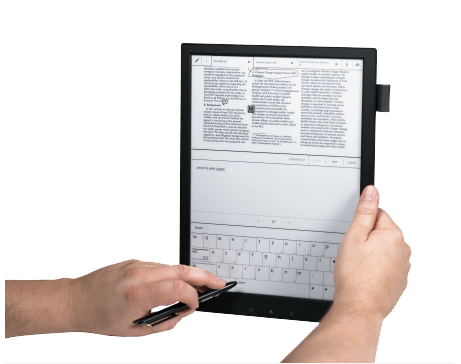“Lovers of print are simply confusing the plate for the food.”
Douglas Adams“It seems to me that anyone whose library consists of a Kindle lying on a table is some sort of bloodless nerd.”
Penelope Lively

I have great faith that e-readers and tablets are going to improve dramatically—and that such improvements will further advance the popularity of e-books. I just hope they don’t wipe out printed books completely—and, frankly, I don’t think they will.
Where paper handling in business is concerned, that is another matter. Here, I think it will probably be a good thing if we really do come close to a paperless office.
In that spirit, Sony are introducing a 13.3” e-reader to the U.S. in May. It will cost you only a modest $1, 100. Its designation is Sony Reader DPT-S1. It’s hardware specs are impressive.
The Digital Reader comments as follows:
In addition to Wifi, a touchscreen, stylus, 2.8GB Flash storage, and a microSD card slot, the DPT-S1 has a 13.3″ Mobius screen, with a screen resolution of 1,600 x 1,200. E-ink announced this flexible plastic-backed screen tech last year, and while it has shown up on a couple smartwatches and smartphone cases, the DPT-S1 is the first product to use the screen (the Earl back country tablet should ship with a 6″ version later this year).
Thanks to the new screen tech, the DPT-S1 is both lighter and more durable than most of its brethren. It weighs in at 358 grams, less than many tablets. This writing slate also has 2 touchscreens, one (optical) designed to work with touch and the other (active digitizer) intended to work with the stylus.
And now for the bad news.
It only supports viewing, editing, and managing PDFs, but no other formats.
Just to give you an idea of how limited it is, the DPT-S1 doesn’t even have an email client. And no, you can’t install apps and add abilities.
Worth having nonetheless? In a business environment—where PDFs are pretty much a standard—possibly yes. But, scarcely a mass market consumer item. Nonetheless, such thin, light, flexible, plastic-backed, screens—in color, even higher resolutions, and in different sizes—are likely to be significant in the future.
IF YOU ARE A WRITER, OR A BOOK PERSON, LET ME RECOMMEND BOOKMARKETINGBUZZEBLOG by Brian Feinbloom. An extract:
“If we look at the bestselling hardcover books for all of 2013, Inferno by Dan Brown (fiction), topped the lists with 1.7 million copies sold. Bill O’Reilly had the top non-fiction hardcover book- Killing Jesus- with 1.5 million copies. 18 hardcover books sold 500,000+ copies- split evenly amongst fiction and non-fiction.
Regardless of format, Americans are buying more units of books than ever before. This is something to celebrate- whether you like fiction or non-fiction, print or e-book.”

Great post.
ReplyDeleteE-readers and tablets contrast in various ways.At the point when endeavoring to choose the two sorts of devices,purchasers ought to take a gander at the distinctions in reason,in size, and in price.A dedicated e-reader,as its name recommends,is not designed to do a great deal more than encourage the reading of electronic materials,particularly eBooks.A tablet,then again,can do everything that a e-reader can do and more.
ReplyDelete***************************
http://compare-e-readers.com